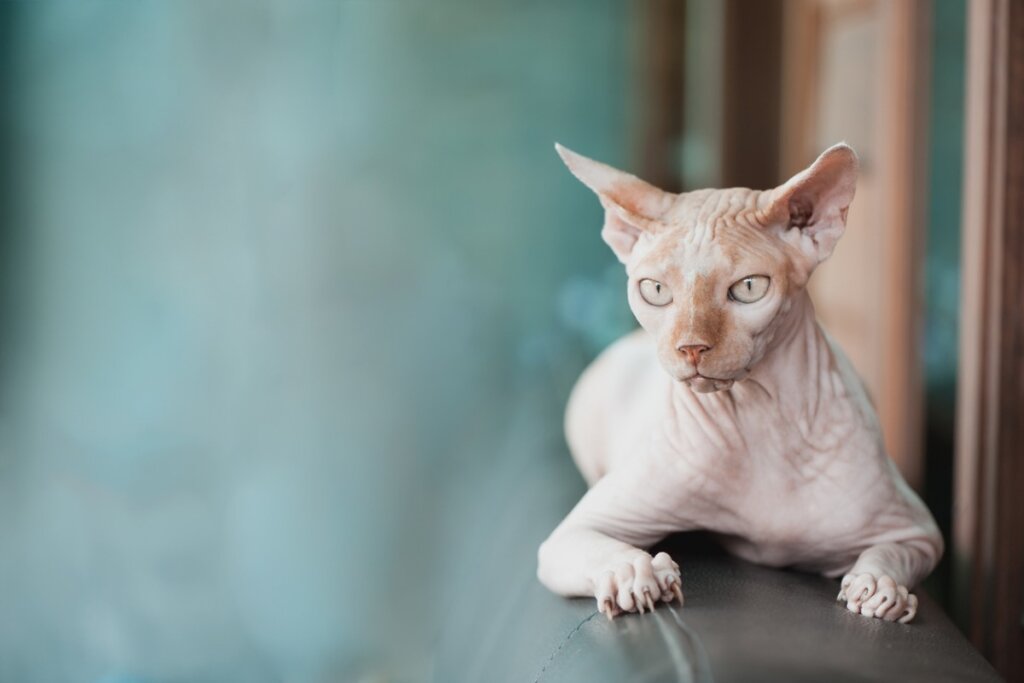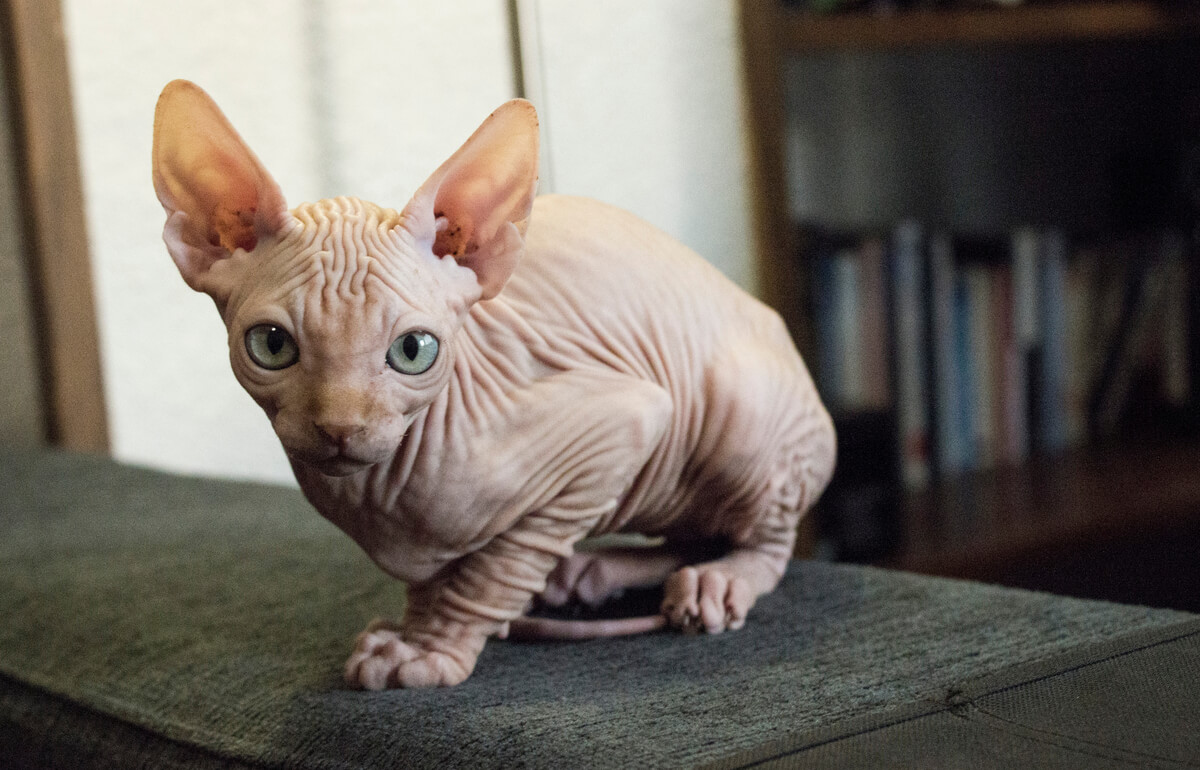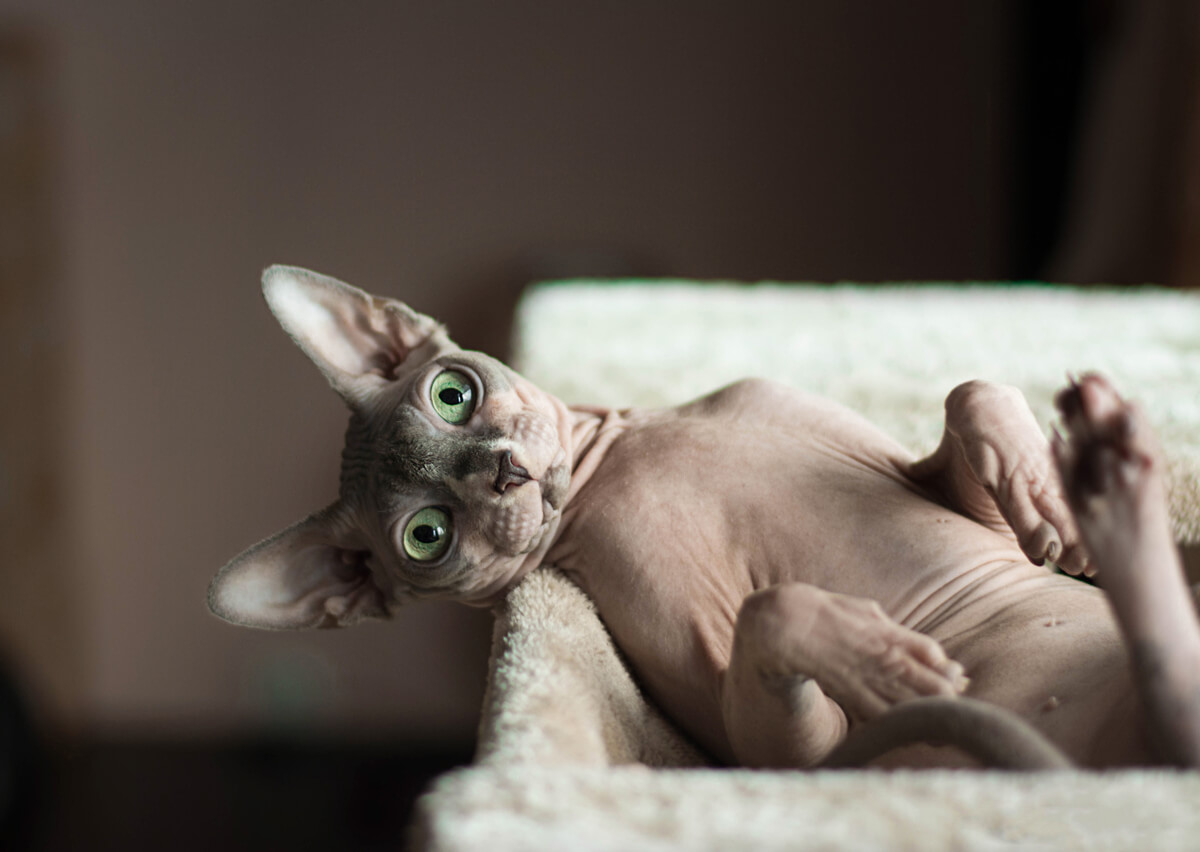Do Sphynx Cats Have Hair?

The first depictions of hairless cats appear in Aztec engravings, although they were already known from Ancient Egypt. This means that sphynx cats are a breed selected by humans from a natural and ancient genetic mutation – that of losing their fur. So, is it possible for sphynx cats to have fur?
However, many owners find that these cats occasionally develop a thin layer of fur. If you’re curious about this, then read on!
Sphynx cat characteristics
Sphynx cats are medium-sized, bulky-chested, muscular felines. Their head has a characteristic shape of the breed, markedly triangular, and some have neither eyebrows nor whiskers. Their body, in fact, is completely hairless (at least if we’re talking about the type of fur we’re used to seeing on other species of cats).
Some breeders encourage crosses that are born without eyebrows and moustaches, but this is condemned by many animal organizations because of the sensory consequences for the animal.
To compensate for the lack of coat, sphynx cats have a faster metabolism than other domestic felines. This results in them secreting a layer of fat all over their skin. These cats get cold in winter and burn in the summer sun, so their epidermis requires special care.
Sphynx cats are hairless due to a recessive genetic mutation. Let’s see what this means in detail.
The genetics of the sphynx
The gene involved in the lack of fur is KRT71, which is responsible for the keratinization of the hair follicle. With this mutation, the hair structure is damaged from conception and the hair doesn’t attach to the skin. It should be noted that the inheritance of the mutated variant (which characterizes this breed) is recessive and autosomal.
Each cell in a cat’s body (as well as almost all living beings) contains 1 pair of each chromosome, one from the father and one from the mother (2n). Thus, each gene has 2 variants or alleles in the karyotype of each specimen. The fact that the sphynx trait is recessive implies the following:
- For a cat of this breed to be hairless, both alleles of the KRT71 gene must be mutated. Recessivity implies that this only occurs if the other allele is equal to it.
- Thus, a sphynx will only be born with the desired characteristics if both parents are sphynx. If it carries one mutated allele and one normal allele, it will have hair.
- The inheritance of this trait is autosomal, that is, it isn’t sex-linked. Therefore, a sphynx can be either male or female and the proportions don’t vary between sexes.

Why does my sphynx cat have fur?
You may have noticed that, if you look very closely, the sphynx cat actually has a thin layer of fuzz covering its fur, especially in winter and when the cold weather sets in. This fluff is not a coat as such, but a reminiscence of it, hence when the temperatures start to drop it’s a little more noticeable.
However, this doesn’t mean that your cat isn’t a true sphynx, as all sphynxes have this feature. However, if it’s more noticeable, it’s possible that your feline has inherited one dominant allele from its parents (the non-mutated one) and one mutated one. Not that it stops being a sphynx because of this, but some people consider these cats to be a “less pure” breed.
Are there other hairless breeds?
Sphynx cats aren’t the only hairless cats, although they are considered to be the quintessential naked felines. In fact, several breeds with this characteristic are often confused with it. Let’s get to know them:
- Donskoy cat: Although it was originally thought that this breed came from the sphynx, genetic research revealed that it was a natural mutation that was then artificially perpetuated. In this breed, in fact, baldness is encoded by a dominant gene and not a recessive one.
- Peterbald: This is a cross between the Donskoy and Siamese breeds. The kittens are born with a little hair and lose it as they grow. They keep some of the pigmentation of the Siamese, as well as their blue eyes.
- Bambino: In addition to being hairless, the bambino has short legs, as it’s a cross between the sphynx and the munchkin breed. Its skin does not secrete as much fat as its hairless parent, so it’s easier to care for.
- Ukrainian levkoy cat: This is a very recent breed, from the beginning of the 21st century. It’s a cross between the Donskoy breed and the Scottish Fold. Another characteristic feature is its ears, which are folded forward.
- Elf cat: This cat with such a curious appearance is the result of crossing the sphinx with the American curl. Their ears folded backwards are the feature that people like the most, as well as their lack of hair.
- Kohana or Hawaiian cat: There still aren’t too many specimens, and so this breed hasn’t been officially recognized yet. It’s believed to be a mutation of the sphinx cat, as it doesn’t have hair follicles and has a similar character.
Did you realize there were so many varieties of hairless cats? People cross these cats looking for certain aesthetic characteristics that people consider fashionable. So, whenever you adopt a hairless cat you should always be aware of the congenital diseases they could carry, as well as the special care their skin needs.
Considerations for allergy sufferers
If you’re thinking of adopting a hairless cat because of your allergy to cats, you should realize that the sphynx are not hypoallergenic. The substance that causes the allergic reaction is a protein present in the animal’s skin that is released with the dander.

Unfortunately, sphynx cats and all the other breeds we’ve mentioned can all produce allergies. While it’s true that this protein isn’t spread through the air (as the animal has no hair), it can be deposited on surfaces, or on you when you pet and handle it. So, before you bring one of these animals into your home, check with your allergist.
All cited sources were thoroughly reviewed by our team to ensure their quality, reliability, currency, and validity. The bibliography of this article was considered reliable and of academic or scientific accuracy.
- Gandolfi, B., Outerbridge, C. A., Beresford, L. G., Myers, J. A., Pimentel, M., Alhaddad, H., … & Lyons, L. A. (2010). The naked truth: Sphynx and Devon Rex cat breed mutations in KRT71. Mammalian Genome, 21(9), 509-515.
- Åhman, S. E., & Bergström, K. E. (2009). Cutaneous carriage of Malassezia species in healthy and seborrhoeic Sphynx cats and a comparison to carriage in Devon Rex cats. Journal of feline medicine and surgery, 11(12), 970-976.
- Genovese, D. W., Johnson, T. L., Lamb, K. E., & Gram, W. D. (2014). Histological and dermatoscopic description of sphynx cat skin. Veterinary dermatology, 25(6), 523-e90.
